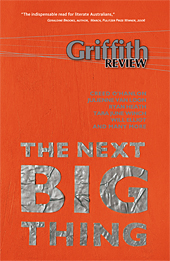Featured in

- Published 20060905
- ISBN: 9780733319389
- Extent: 288 pp
- Paperback (234 x 153mm)
“We can’t earn your respect so we’re gonna buy it.” – The Presets, at the Tsubi Jeans and Modular Records Christmas Party, December 2005
“To marketers it no doubt all seems a little harsh on the side of the detractors, but as I have said before in this space, the new comms tools are in the hands of the consumers, if you want to play with them you need to do so cautiously or it could backfire in a massive way.” – B & T weblog, referring to the grandiose failure of the Coke Zero campaign, www.thezeromovement.com, January 2006
“We don’t try to be something we’re not; it’s more about representing the community and promoting Melbourne than us making any money.” – Karl Stanton, co-founder of www.niceproduce.com, April 2006
“Tight pants. Big dreams. Bending over for the mainstream.” – FrankieTeardropESQ, www.messandnoise.com, February 2006
“Still united by hate.” – advertisement for Vice magazine, January 2006.
IT’S EASY TO buy something these days without knowing who’s selling it. Converse used to be punk, now it’s an arm of Nike. MySpace.com used to be a cultural networking tool, now it’s ad space for Rupert Murdoch.
Brands have long known the value of mimicking and even purchasing subculture: the big race for authenticity began in the early ’90s. Indeed Generation Y, in its quest for individuality, may have sped up the process. But what about instances where subcultures themselves have begun to compete commercially? In the world of the “small sell”, the line between cultural production and branding is blurred.
There has been a lot of talk about our generation’s disdain for labels. On the one hand, it is difficult to label us. What does Generation Y even mean? It is hard to pinpoint a unifying element, other than our age, which may or may not be fifteen to thirty. Ryan Heath has attempted a definition in Please Just F* Off, It’s Our Turn Now (Pluto Press, 2006), although he concludes that we are really only unified by our diversity. We have certainly grown up together in a golden age of advertising. While we seem to embrace capitalism and consumption, we are cynical about labels. We have an inbuilt suspicion of the big sell.
This sentiment was best captured by Naomi Klein’s branding overview NoLogo (Flamingo, 2001), which brought into focus the corporate backlash of the ’90s and beyond. More a commentary than a call-to-arms,NoLogo clarified a general itchiness we might have felt about the emergence of a global corporate lawlessness, about brand dominance, the proliferation of culture marketing, and particularly the colonisation and mimicry of subculture by global brands.
As Klein charted, brands became aware of our generation’s disdain for the big sell, and began to use our own subcultures to market to us. The new race became one of self-representation. And what a golden age of advertising this has spawned. Where catalogues are indistinguishable from ‘zines and independent street press; where school children are employed to up-sell clothes to their peers; where graffiti artists are head-hunted to work on shop fit-outs; where the seeding of “social epidemics”, in the words of Malcolm Gladwell, has become the spending priority in marketing budgets.
Our visual and physical spaces are now crowded with marketing that is often indistinguishable from our own cultural production.
SO HOW HAVE Gen Y subcultures responded? These skaters, indie-kids, breakers, graffiti crews, tech-nerds and rockers? Klein assumes that we resented the accelerating absorption and re-sale of our identities. But are we really fighting back? NoLogo places a vague faith in “… an activism that is sowing the seeds of a genuine alternative to corporate rule.” But where is it and what form does it take? We are not a unified or politically driven generation. Our culture-jamming is prolific, but it’s not organised. Adbusters magazine and websites like www.worth1000.com have made an artform of advertisement critique and this has become an amusing pastime for thousands of graphic artists, bloggers and film editors who spoof, deface and re-edit corporate messages as they emerge. Yet brands invest billions of dollars in staying ahead of this backlash. They are selling our own attitude back to us, employing us as advisors, and, in the case of General Pants, asking us to submit our own artwork to their catalogues.
As Klein point out, marketers tell us we live in “the global village, an incredible place where tribespeople in remotest rainforests tap away on laptop computers.” The question is: how is our generation using this power? Perhaps we are failing Klein. Rather than reading between the lines of the happy rhetoric and fighting a globalism where the economic divide continues to widen, we seem to be embracing the market’s new global scalability.
In a globablised world, where we hold the card of authenticity that brands try so hard to play, there is nothing stopping us from becoming our own cultural salespeople. In order to sell to us, effectively the brands need to emulate us. But we are also becoming our own brands. We can bypass brand absorption and operate not as brand avengers, but as independent, subcultural entrepreneurs. Maybe this is our activism?
When it comes to the small sell, global corporations and creative individuals jostle for consumer attention, and authenticity is paramount. Individuals who trade on their own subcultures have the upper hand, yet they must also walk a careful line, to maintain a profit on the one hand, and their cultural credibility on the other. Even a partial profit motive can be met with calls of exploitation.
So how is the subcultural entrepreneur to survive, let alone prosper, in this market? Most of these enterprises begin by serving their own community. But with some success comes the potential for new audiences, more sales, bigger enterprise, as well as disillusionment from their original community. How these challenges are met can mean the difference between make and break.
We’ve compared the careful rise of a few established local ventures.
KARL STANTON AND Alex Mitchell founded the Melbourne-based “street” retail website www.niceproduce.com. The site was created to serve as a forum for announcing upcoming exhibitions and events. It’s also an online store for designers and artists to sell merchandise from events as well as other limited edition products. Nice Produce has a reputation for providing grassroots access to the latest in “street” subcultures, particularly skate and hip hop, and has a large audience within those communities. “Alex and I are also big consumers and, like everyone, can see through large companies trying to ‘get real’ with the culture,” says Stanton. “Most of their attempts are piss weak and generally shit. We don’t try to be something we’re not.”
The power of the small seller continues to grow as brands focus their sights and shrink commercial playing fields, while quite often missing the cultural mark. Coke Zero launched with a fake blogstream and was quickly found out and undermined. Levi’s commissioned a series of gigs in Melbourne recently called “Children of the Night” (www.childdrenofthenight.com.au) – an event not much larger than the fundraiser parties of local independent street press publications such as Opulent magazine. Yet debate raged for days on the website www.messandnoise.com about the commercial motive of the party and the ethics of playing for a brand.
So what motivates people like Mitchell and Stanton? Subcultural enterprise should be judged first on its own definitions of success. Is it to beat the brands on profit? To enact a market-based activism? To promote visibility? To defend subculture from brand absorption? To make a good living? The aims are not always clear.
Monkey runs Melbourne’s Rancho Notorious, a skate and graffiti culture hole-in-the-wall store in Caledonian Lane, Melbourne, which sells limited edition T-shirts, hand-painted caps and spray cans. The walls in this tiny space are adorned with ever-changing artwork, and the lane is famous for Monkey’s oversized jungle-girl pieces. The store is not profit-driven beyond the need to provide a basic livelihood. Many graf writers turn their skills to profit as graphic designers and illustrators, but Rancho Notorious is a way for Monkey to make a living but still invest as much of his time in graffiti culture as possible. While aware of the novelty value his store presents to the mainstream, and the leverage this novelty brings, he is not interested in targeting a mainstream audience.
Monkey is aware of the conundrum of trading on graffiti, an artform that is both anonymous and illegal by its very nature. Yet his allegiance to the culture includes promotion of its illegal nature, despite the limitations they place on his business. He argues that the artform exists as a dialogue between those who write and those who “buff” (clean the walls), and that both parties are integral to a relevant and healthy graffiti culture.
Karl Stanton gives an equally un-business-savvy explanation for his increasingly successful enterprise: “We never intended to target anyone, the web is a very open, cross-culture platform, anyone can be watching, we’re happy to stick to our guns and if there’s success then fantastic.”
Unlike Monkey and Stanton, Andrew Mac, who runs Until Never Gallery in Hosier Lane, Melbourne, acknowledges that part of the reason he went into business was to make money. However, he also believes the gallery, which combines contemporary art with street art, plays a part in the evolution of an artform.
Mac actively champions the right to proper remuneration and recognition for artists and has served as an informal “agent” to several street artists being approached for commissions. He strongly opposes the tendency he has encountered for corporations to treat a commission as a favour to an artist, trading in exposure rather than cash. And, notably, while he encourages paid work for artists, he will still refuse a project that he feels lacks artistic merit, even if it is likely to make him a lot of money.
ALL OF THESE enterprises, like the subcultures they represent, are of a limited size – they are based on the people in the local scene. In contrast sits a venture such as Vice magazine. Vice was founded in Montreal as a skateboard ‘zine, produced by three Montreal “junkies” in 1994. It now publishes international editions in twelve regions, including Australia, and oversees numerous subsidiary companies including Vice Records, Vice Film, Vice TV and Vice Recordings. In 2005 Business Week Online reported that Vice would generate roughly US$14 million dollars in advertising revenue for the year. In the words of the founders, “Vice has become much more than a way for three guys to get laid. It’s become a lifestyle; a degrading and disgusting lifestyle of sex and drugs and rock and roll and death.”
Vice is arguably the largest, most profitable explosion of subcultural enterprise the world has ever seen. And it still publishes the kind of random extremism that kept those skateboarding punks motivated, above and beyond their junk habits in 1994. But given its global expansion, the question might be asked: how genuinely does the Vice “lifestyle” transfer to its franchises? A girl from Melbourne’s suburbs, Briony Wright, is editing the Australian Vice magazine. Apart from meeting the founders during a stint in New York, Wright has no experience of Montreal skate-culture.
Wright believes Vice’s success comes partly from consistency. “The Vice attitude, which combines humour and honesty, has been the same since the magazine’s inception and has created an evolving culture of readers who relate to what we say.” So in some ways, the magazine still has roots in its original subculture – or at least in its original voice – but has garnered a much wider audience.
Maintaining cultural authenticity seems to hinge on a perceived ongoing association with, and investment in, the source culture. For example, the success of Rancho Notorious hinges on Monkey continuing to regularly produce prominent and impressive street art. Stanton and Mitchell each have fingers in a range of pies, including DJing, clothing labels, and co-ownership of other culturally niched businesses. Their involvement in these projects and events, like the skate exhibition No Comply, further bolster their kudos, and can be seen as a reinvestment in the cultures they promote and profit from (even when one project clearly serves another, such as Mitchell’s clothing label Shadow, which is featured on Nice Produce). Interweaving interests in this way appears acceptable so long as those interests also have cultural credibility.
Equally important are the associations that are absent from these projects, such as those with investors, advertisers or brands whose interests are not seen as having cultural integrity. Mac turns down well-paying commissions that he can’t artistically justify. Vice magazine, which is riddled with advertisements, keeps editorial resolutely separate from advertising. (In fact, the editorial offends advertisers, who nevertheless continue to buy ad space.)
As Monkey is only too aware, Rancho Notorious owes its existence to a community who will “flame” you at the first sign of “selling out”. “As soon as you make that one dodgy decision. You might have done great things for years, but that’s what they’ll remember.”
As corporations embark on small scale productions like the General Pants ‘zine or Children of the Night, and underground producers like the Vice founders are developing global empires, it seems that cultural authenticity cannot be determined by size alone. Consumers of our generation, as Ryan Heath points out, understand the cultural significance of their consumption. We are a networked generation of individuals and we consume as individuals. We represent “hundreds of little movements … our consumer choices are based on personal values as well as need”.
As these examples demonstrate, there is scope for entrepreneurs to profit from their subcultures, with values intact. They might even found an empire. Yet there is one thing each of these enterprises has in common, of which corporations are very aware: they have communities, not demographics.
If the small sell is the next big thing, perhaps the power of this generation of consumers and cultural producers lies not in our potential to lead a brand backlash, but in our ability to lead marketing culture itself. And, in doing do, stand guard around our own cultural terrain.
Share article
About the author

Natasha Ludowyk
Natasha Ludowyk was a co-founder of the much loved, unprofitable and now-defunct Melbourne-based publishing eccentricity Is Not Magazine.She currently works as a researcher and...
More from this edition

Mending a broken link
Memoir I'M CELEBRATING MY mother. Pink tissue paper and ribbon fold and tie over the gift: foot lotion. Lavender scented. A present for the Mother's...

Revenge of the geeks
EssayTHE TOMORROW PEOPLE now seems very "yesterday". It is fondly remembered as a poor man's Doctor Who – and as Doctor Who was notoriously cheap, that's not saying much....

Requiem
FictionSelected for Best Australian Stories 2006ON MARCH 11, 2004, Fresneda walked down the street outside El Pozo station in Madrid. It was a beautiful...